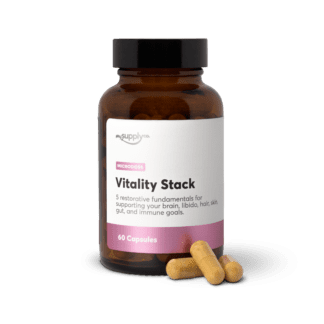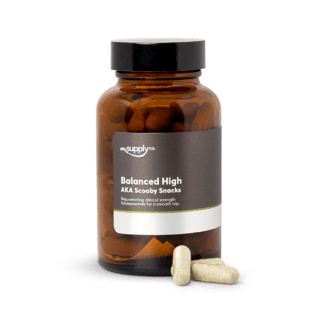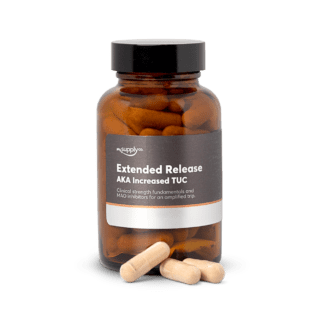Key takeaways.
-
What are the differences between different magic mushroom strains?
The strength of psychedelic mushroom strains can vary significantly. Some strains deliver more intense experiences than others due to variations in their psychoactive alkaloid content, the most popular being psilocybin and psilocin, classic psychedelic compounds that act primarily through serotonin 5-HT2A receptors. The Fly Agaric, on the other hand, is one of the strongest psychedelic mushroom strains known, and contains psychoactive alkaloids that act through GABA, Glutamate, and Acetylcholine receptors.
-
What makes the strongest mushroom strains the "strongest"?
In the case of Psilocybin mushrooms, the amount of psilocybin and psilocin, the active psychedelic compounds, are the primary determinants of potency. Strains with higher psilocybin concentrations tend to be the most potent.
-
What can I expect from the strongest magic mushroom strains?
The strongest mushroom strain can offer diverse experiences, including vivid visuals, altered perception of time, and deep introspection, making them a subject of interest for recreational and therapeutic purposes.
You might perceive nothing at all (a sense of nothingness), the inability to differentiate between a thought or object or physical sensations, complete dissolution of boundaries, the loss of identity, or new dimensions, parallel realities, alternate universes, and aliens. Some even describe the strongest magic mushroom strains as being DMT-like!
You've probably heard of Golden Teachers (Psilocybe cubensis) and Liberty Caps (Psilocybe semilanceata). But what about Psilocybe azurescens or Panaeolus cyanescens? And did you know there are over 200 species of psilocybin-containing magic mushrooms in the world? Read on to discover the 10 strongest magic mushrooms on Earth.
Mushrooms have long been revered for their diverse uses, from culinary delicacies to powerful medicinal agents.
Hidden within the fungal kingdom lies a category of mushrooms that has captured enthusiasts and researchers’ fascination—psychedelic mushrooms. These remarkable fungi, known for their mind-bending and mind-mending properties, have been cultivated and consumed for centuries, offering unique experiences and therapeutic potential.
It might be that you’re only aware of one or two types of magic mushrooms. However, there is a staggering 200+ species out there—and we're discovering more every day, ranging from highly potent to fairly mild.
In the realm of psychedelics, the potency of these mushrooms can vary significantly, with certain strains standing out as the most potent and sought-after. Let us uncover the extraordinary world of the strongest mushroom strain and its impact on the human psyche and beyond.
In this guide, we list the top 10 strongest magic mushrooms on Earth.
Disclaimer:
This is just an informational article about the strongest magic mushroom strains. This is not a guide for picking magic mushrooms. Only mycologists should go out and pick mushrooms. We don’t recommend going out to identify magic mushrooms beyond pure leisure, as it’s very easy to accidentally pick a poisonous mushroom. Please do not use this as a guide for picking magic mushrooms.
What makes a mushroom "magic"?
Magic mushrooms. Everybody's heard of them by now. They've played a rich part in our history and evolution, and today they are being lauded for their therapeutic potential. But how well do they know them, really?
At their core, magic mushrooms are special types of fungi that induce a psychedelic experience. But how do they do this? And which mushrooms are capable? And are all psychedelic mushrooms "magic" mushrooms?
Many species of mushrooms contain psychoactive compounds that cause some sort of expanded state of consciousness. But when talking about magic mushrooms, we're not necessarily talking about any mushroom with psychedelic effects. For instance, the famous Fly agaric mushroom from the Amanita muscaria species (which is a deliriant or hypnotic) is certainly psychotropic, but it doesn’t always fall into the traditional magic mushroom category.
That's because the term "magic mushrooms" traditionally refers to those that are widely circulated and studied. More specifically psilocybin mushrooms, which contain the active substances psilocin, psilocybin, and, to a lesser extent, baeocystin.
For this guide, we're only listing the most potent psilocybin mushrooms.
What makes shrooms potent?
The science behind magic mushroom potency is a fascinating exploration of the compounds, factors, and precautions that shape the psychedelic experience. At the heart of this exploration is psilocybin, the primary active compound responsible for the profound effects of psychedelic mushrooms.
Psilocybin, once ingested, is converted into psilocin in the body, which interacts with serotonin receptors in the brain, triggering altered perceptions, vivid visuals, and introspective journeys. However, the potency of mushrooms varies significantly, influenced by many factors.
Understanding these variables is necessary for those seeking a predictable and safe experience, underscoring the importance of accurate dosing. Precise dosing ensures that individuals can navigate the transformative world of psychedelic mushrooms with greater confidence and minimize potential risks, making their journey both enlightening and safe.
Read: The Ultimate Magic Mushroom Dosage Guide
The active ingredients in magic mushrooms.
As mentioned earlier, there are three main psychoactive compounds in psilocybin mushrooms:
- Psilocybin, which is converted into psilocin by the liver
- Psilocin, the psychoactive compound that produces the actual psychedelic effects
- Baeocystin, a derivative of psilocybin that isn't well understood but is known to contribute to the overall effects
But there are also other compounds in magic mushrooms that can alter the psychedelic journey.
For example, in addition to psilocybin, psilocin, and baeocystin, magic mushrooms contain MAOIs, compounds that inhibit an enzyme in the body responsible for the breakdown of certain neurotransmitters.
The ratio of these compounds is not the same across species, subspecies, or even within groups of the same mushroom. Together, they give every mushroom strain an entourage effect, much like cannabis strains have their own entourage effect.
And how they’re balanced influences the which influences the effects, nature, and intensity of the mushroom trip as a whole. Some can be more visual, while others can be more meditative.
Psilocybin.
Psilocybin, a precursor to psilocin, is a naturally occurring psychedelic compound found in certain species of mushrooms, often referred to as "magic mushrooms." When ingested, it undergoes a transformation within the body. Also known as a prodrug, psilocybin itself is inactive, but it's converted into its active form, psilocin, by enzymes in the liver. Psilocin is the real agent responsible for the mind-altering effects.
While this substance is ultimately responsible for initiating the high, it must first be metabolized in the body into psilocin before actually exerting hallucinogenic effects. This process can also be carried out artificially before consumption.
Think of psilocybin as a unique key, and your body as a lock. When you consume magic mushrooms, you're essentially inserting the key (psilocybin) into the lock (your body's enzymes). This action unlocks a door to altered perception and consciousness, much like how a key can open a door to a different room. Psilocin activates serotonin receptors in the brain, leading to changes in thought processes, mood, and sensory experiences. This cascade of serotonin receptor activation, particularly in the prefrontal cortex, is what's behind the vivid visuals, altered sense of time, and profound introspection that people often experience on psilocybin.
It's important to note that while this analogy simplifies the process, the effects of psilocybin are far-reaching, and its potential therapeutic applications and psychological impact continue to be a subject of scientific exploration.
Psilocin.
Once ingested, the body metabolizes psilocybin into psilocin.
Psilocin is found most abundantly in fresh mushrooms, or in lemon tek—a process whereby psilocybin is converted into psilocin using lemon juice. Psilocin is the substance in mushrooms that directly interacts with the body and causes the psychedelic trip.
Psilocin is structurally similar to serotonin, a neurotransmitter that plays a key role in regulating mood, perception, and various cognitive processes. When psilocin enters the brain, it interacts with serotonin receptors, particularly the 5-HT2A receptor. This interaction disrupts the usual patterns of serotonin transmission, resulting in changes in thought patterns, mood, and sensory perception. It's like a guest arriving at a party and shaking up the usual rhythm—everything begins to flow differently.
The presence of psilocin in the brain leads to the vivid visuals, emotional depth, and altered sense of self and reality that people often experience during a "trip." The exact mechanisms behind these effects are still under investigation, but it's clear that psilocin's interaction with serotonin receptors plays a pivotal role in the psychedelic experience.
Baeocystin.
A derivative of psilocybin, baeocystin is the lesser-known and studied sibling of psilocin and psilocybin. Exactly what role it plays, or what effect it has on the body, is unknown. During the few times baeocystin has been administered alone, it exerted comparable effects to an equivalent dose of psilocybin. However, a more recent study from 2019 saw no significant change in mouse behaviour when given baeocystin compared to saline solution.
However, it's generally accepted that baeocystin can produce psychedelic effects when ingested, although it is generally considered to be less potent compared to psilocybin and psilocin.
To draw an analogy, if psilocybin and psilocin are the lead actors in the psychedelic experience, baeocystin might be considered a supporting character. It's like a member of an ensemble cast, contributing to the overall experience but perhaps not taking center stage. Baeocystin's precise role and its effects on the brain's neurotransmitter systems are still being studied, but it's thought to have some influence on the overall character and duration of the trip, enhancing the nuances of the experience.
The interactions of baeocystin with serotonin receptors and its exact contributions to the psychedelic journey are areas of ongoing research, making it an intriguing and increasingly recognized component of the magic mushroom experience.
The most potent mushroom strains revealed.
Psychedelic mushrooms have long fascinated humanity with their diverse effects and potential therapeutic benefits, from boosting neuroplasticity and optimizing mental function to healing depression, trauma, and addiction.
Let us explore some strains of the most potent mushroom species, highlighting their characteristics and effects.
At this point, it's worth noting that available information on magic mushroom species is limited. Where possible, the concentrations of psilocybin, psilocin, and baeocystin will be given as a percentage of the dried mushroom. However, these figures are not available for all magic mushroom species, so the stats will vary from species to species.
The numbers given here should only be used for a rough indication of the ratios you can expect. That being said, they should give you some insight into these wonderful, mystical organisms.
For a summary of the strongest magic mushrooms, skip to the potency chart.
Do not forage for mushrooms alone:
But if you intend to pick any of these strains in the wild without a trained mycologist, make sure you know exactly what you are looking for. Many strains have lookalikes that are incredibly toxic and even deadly.
1. Flying Saucer Mushrooms — Psilocybe azurescens.
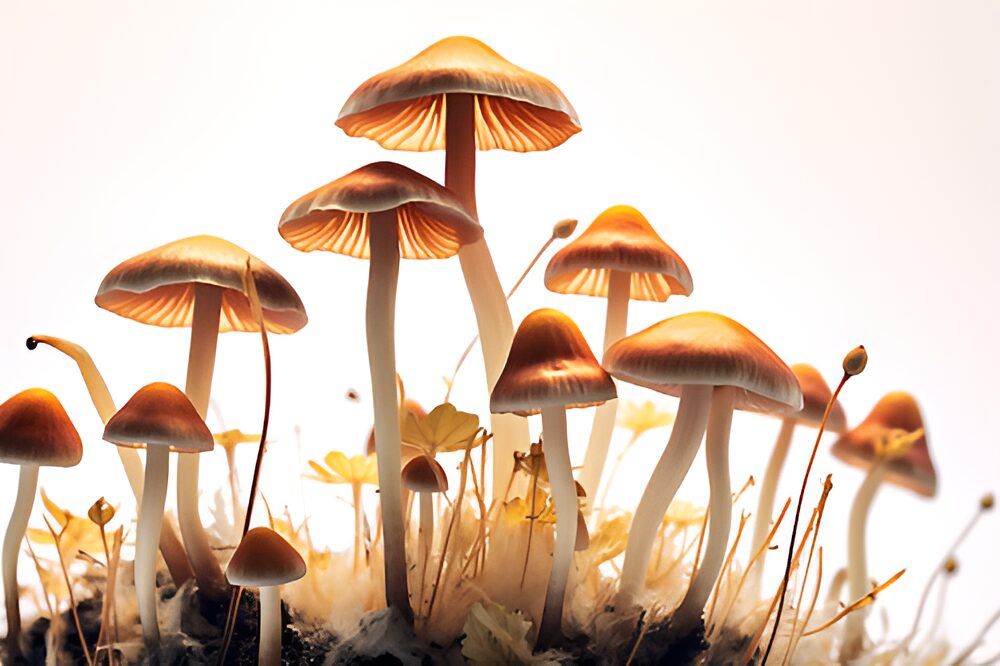
If you’re a fan of intense visuals and profound inner journeys, look no further.
At the top of our list is Psilocybe azurescens, commonly known as Flying Saucers. It is infamously the world’s strongest magic mushroom—if you can get your hands on it. In the wild, you likely won't find it anywhere outside of the deciduous woodlands near the Columbia River on the U.S. West Coast.
A strong word of caution, higher doses of the Flying Saucers can result in what's called wood-lover's paralysis, a temporary form of paralysis caused by certain wood-loving varieties of magic mushrooms. This can make you feel anxious and throw you into a bad trip if you aren't prepared for it, so be mindful of the possibility.
Microdosers favor these magic mushrooms because of their potency. As the saying goes, less is more.
Read: The Ultimate Guide to Magic Mushroom Microdosing
Psilocybe azurescens contains a psychedelic mixture of up to 1.8% psilocybin, 0.5% psilocin, and 0.4% baeocystin.
While these percentages may sound underwhelming, they're enough to transport you into another realm entirely. Start low, and go slow.
2. The Copelandia Hawaiian — Panaeolus cyanescens.
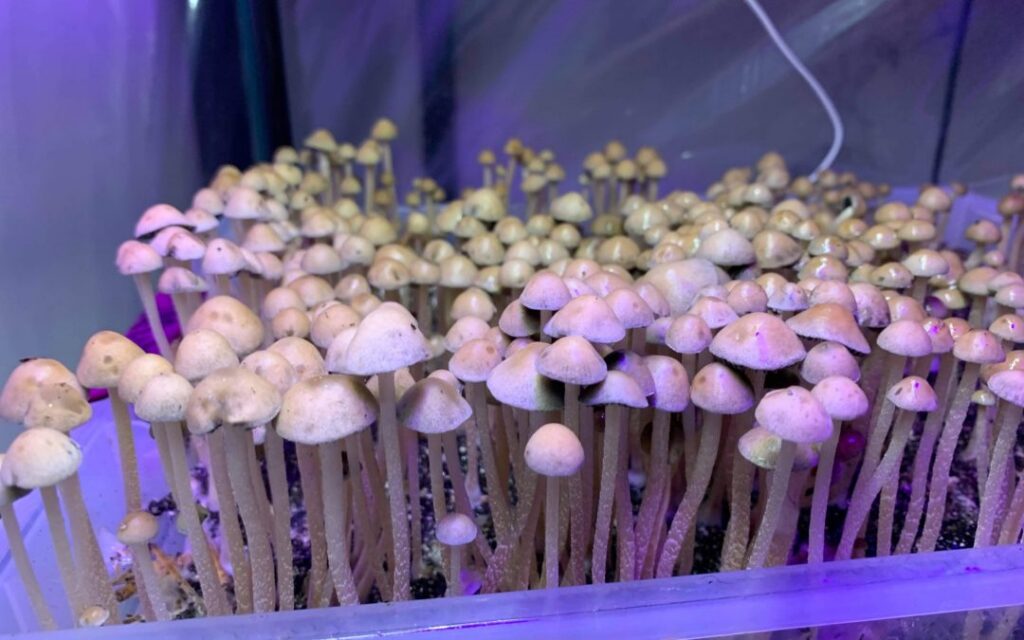
Panaeolus cyanescens—also known as Copelandia cyanescens, “The Hawaiian,” or Blue Meanie— is frequently mentioned as being more potent than P. cubensis, with some reports saying it can contain two to three times the psilocybin and psilocin concentrations.
This is a hardy mushroom that can easily be grown indoors! The intense trip and beginner-friendly nature make this magic mushroom species perfect if you're just getting into cultivation. They thrive in dung wherever it's found around the world—which is why Panaeolus cyanescens kits use horse manure as substrate.
These magic mushrooms contain approximately 2.5% psilocybin and 1.94% psilocin, making them some of the most potent shrooms around.
3. Wavy Caps — Psilocybe cyanescens.

Psilocybe cyanescens, or Wavy Caps, is a species of potent psychedelic mushroom that's becoming increasingly popular because of the widespread use of mulch.
These mushrooms are native to Central Europe and the Pacific Northwest, but they can now be found all over the world. They’re known to prefer environments with woody debris such as chips or gardens but can also grow outside in environments that are abundant with dead trees.
Wavy caps are notoriously potent; they can contain 0.3% to 1.68% psilocybin, 0.28% to 0.51% psilocin, and 0.022% to 0.29% baeocystin.
When lucky enough to find them in the wild, you might discover these mushrooms thriving on trees. The caps are typically small and green before they grow into an enormous patch of wavy brown-colored flesh that retains more potency when eaten fresh as opposed to dried. Although not as intense, dried wavy caps still produce profound effects.
4. & 5. Psilocybe serbica var. bohemica and moravica.
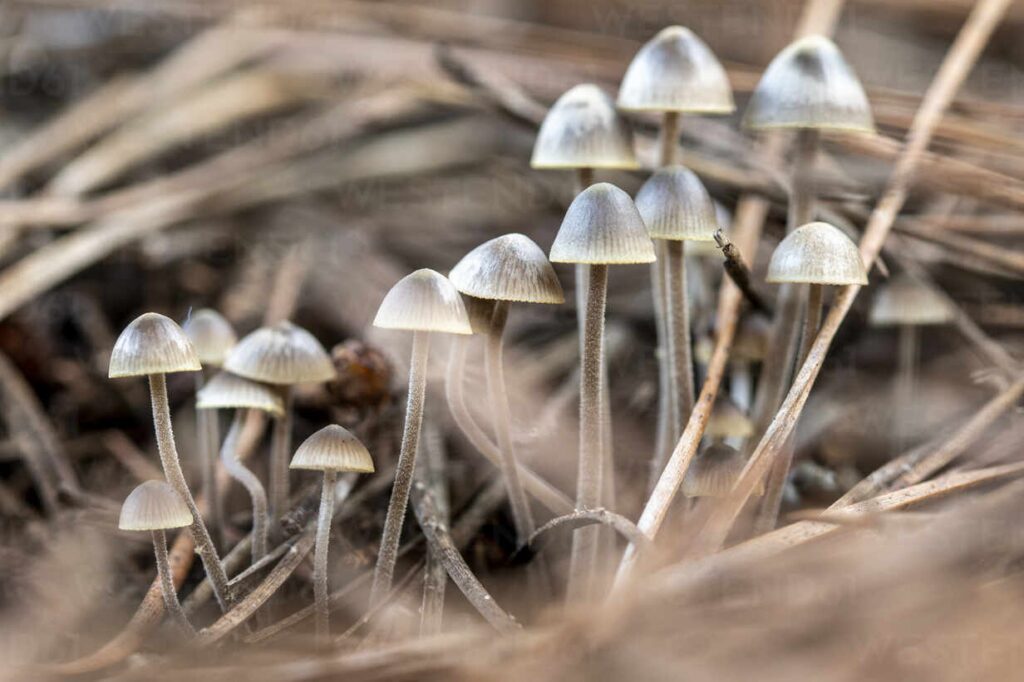
Mushroom naming can be tricky, especially when all mycologists might have to go by are descriptions from other mycologists. Luckily, advances in DNA testing have challenged historical species descriptions, as exemplified by Psilocybe serbica and its companions.
Initially, they were thought to be distinct species, even by mycologists. Then DNA studies in 2010 revealed that P. serbica, P. bohemica, P. arcana, and P. moravica are genetically identical. Some still argue that P. bohemica is simply a younger growth stage of P. serbica.
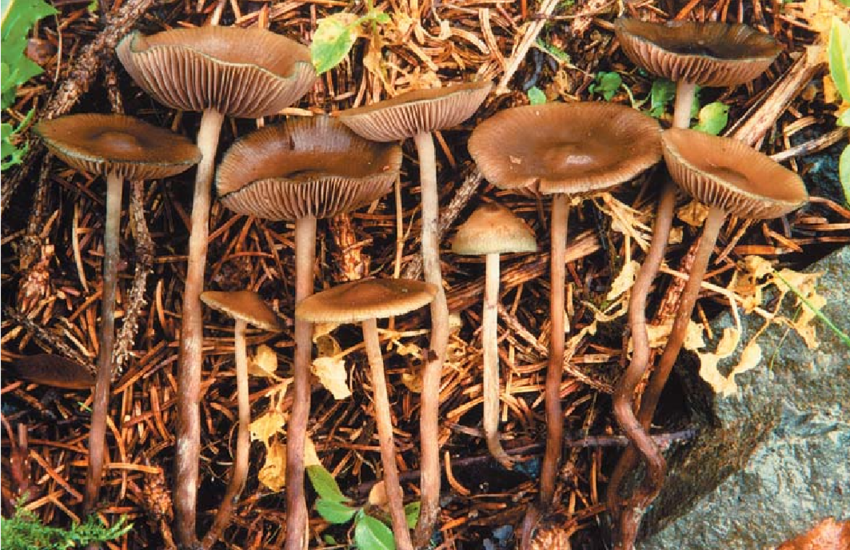
As per taxonomic tradition, the name Psilocybe serbica persisted as the oldest description, while the others were considered varieties (or strains) of P. serbica due to differences in appearance. These variations among P. serbica varieties may be due to differences in their natural habitats and growth conditions, akin to distinct varieties of Psilocybe cubensis cultivated by home growers. Unlike P. cubensis, however, P. serbica varieties naturally developed.
When dried, P. serbica var. bohemica's concentration of psilocybin, psilocin, and baeocystin ranges between 0.11% to 1.55%, 0.023% to 0.25%, and 0.0027% to 0.25% respectively.
When dried, P. serbica var. movarica's concentration of psilocybin, psilocin, and baeocystin ranges between 0.57% to 1.42%, 0.029% to 0.082%, and 0.0061% to 0.0386% respectively.
A word of caution for those foraging for these mushrooms —they are easily confused with the Galerina, which is a highly poisonous fungi.
Don’t consume anything that may be dangerous to you!
6. Liberty Caps — Psilocybe semilanceata.

Psilocybe semilanceata, more commonly known as Liberty Caps, are widely recognized for their prominent nipple-like feature and bell-shaped cap.
For many, Psilocybe semilanceata is the quintessential magic mushroom. That's because, in addition to being one of the most potent mushrooms, it's also the most widespread magic mushroom in the wild, growing across 17 countries in northern Europe, where it is considered to be native. There are reports of it being found further afield than this too.
These magical little creatures boast the highest levels of psilocybin ever measured—these mushrooms are not your average fungi.
The psilocybin levels in dried Psilocybe semilanceata samples have been found to be as low as 0.2% and as high as 2.37%; however, the average concentration is only 1%, which is why it's sixth on our list.
7. Psilocybe cubensis.
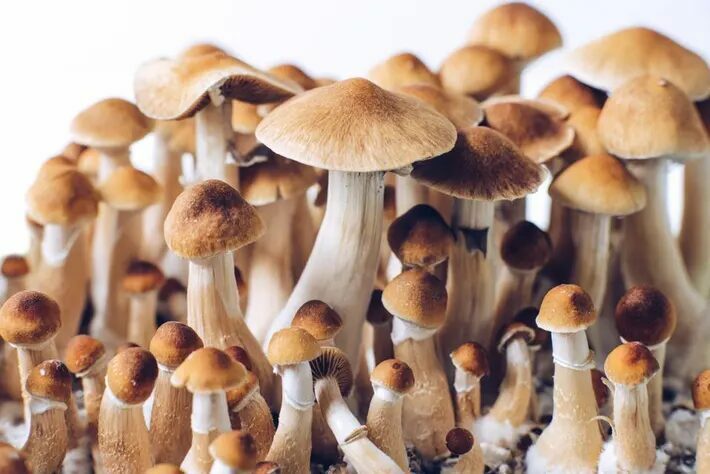
Psilocybe cubensis is one of the most commonly sourced magic mushroom species because it is the most easily cultivated and its effects are well-loved by many. Most of the grow kits available online contain P. cubensis mycelium.
They're also favored by the clinical and research communities because of their ease of growth, and many different subspecies have been bred, making it a versatile species. As such, they have a very large range when it comes to concentrations of indoles.
In the wild, Psilocybe cubensis is found spread across the world in tropical climates.
Dried, the concentrations of psilocin and psilocybin are 0.14% to 0.42% and 0.37% to 1.30%, respectively.
If you buy a grow kit commercially, you will have a better idea about the potency, which can make Psilocybe cubensis great for beginners. This is because they can be easier to accurately dose compared to wild strains.
We use the Golden Teacher strain of Psilocybe cubensis in all of our microdose and macrodose capsules, including Brain Stack, our nootropic microdose supplement, and Balanced High (a.k.a. Scooby Snacks), our uplifting macrodose formula. Golden Teacher is known for its relaxed and gentle trip, allowing you to explore your inner thoughts, emotions, and perceptions in a supportive and manageable way. The balanced intensity and clarity offers a transformative psychedelic journey without overwhelming or confusing sensations.
8. Conocybe cyanopus.

Conocybe cyanopus is a lesser-known species of magic mushroom. And for good reason; it looks incredibly similar to a couple of deadly species that grow in the same environments. As a result, it is usually not worth taking. As there will be other species available that come with a much lower risk, we recommend that you stay away from this species unless you are an expert or in the company of one.
That being said, Conocybe cyanopus still deserves a place on this list due to its strength.
Dried, it contains somewhere between 0.5% and 1% psilocybin.
9. Psilocybe zapotecorum.

It is named for the Zapotec Indians native to the Sierra Madre mountains of Oaxaca, Mexico, and the area they inhabited. It was likely the mushroom used during their ceremonies. According to Richard E. Schultes, the Zapotec name translates as "Crown of thorns mushroom". Other sources give the Zapotec name as badao zoo translated as "hongo borracho", "drunken mushroom," or "drunken god."
Psilocybe zapotecorum is often found in subtropical forests, and can be seen growing in Argentina, Brazil, Chile, Colombia, Mexico, Peru, Guatemala, El Salvador, Venezuela, Nicaragua, and Ecuador.
One of the more potent mushroom species we've discovered, dried specimens can contain 0.9% to 0.97% psilocybin, 0.029% to 0.037% psilocin, and 0.043% to 0.481% baeocystin.
10. Koh Samui Magic Mushrooms — Psilocybe samuiensis.
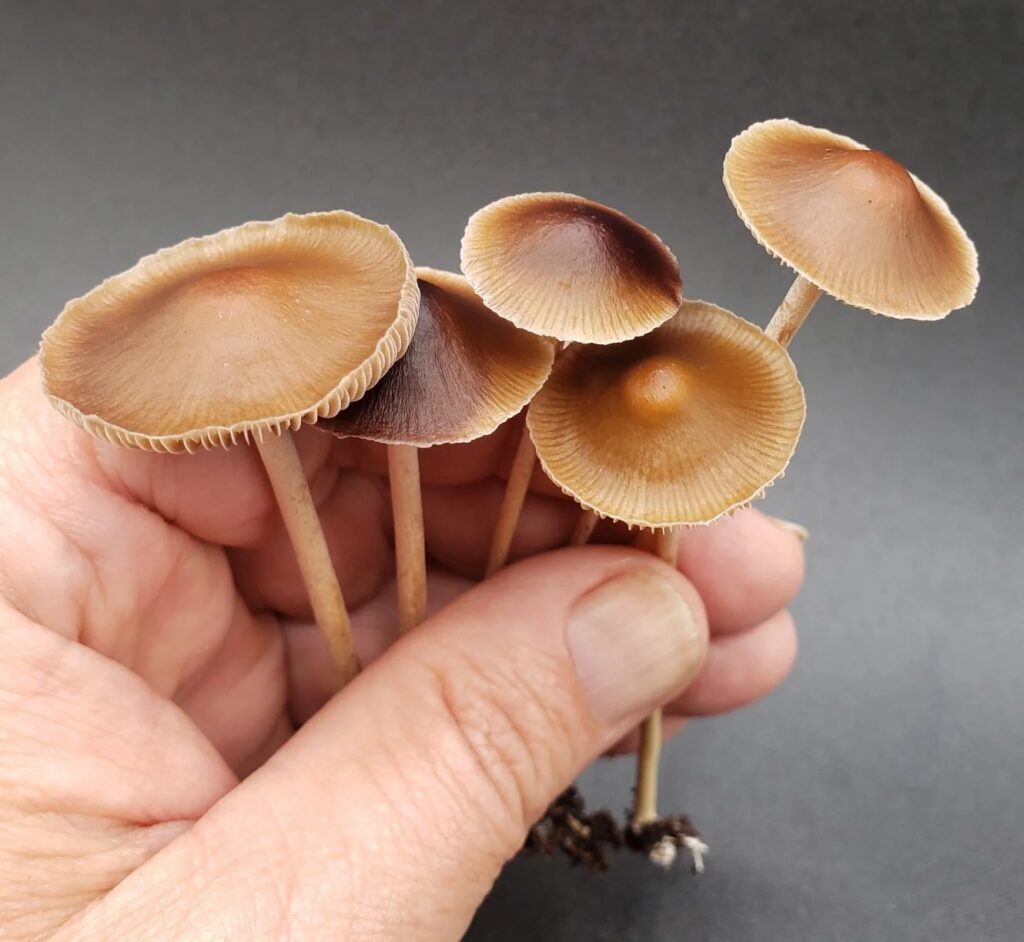
Found in Thailand, this is another tropical species of magic mushroom. Initially only known to grow on the island of Koh Samui, it has since been found in other locations too. It is wide, with a reddish-brown cap, and grows quite thick.
The ratios of psilocybin, psilocin, and baeocystin in dried specimens are: 0.023 - 0.90%, 0.05–0.81%, and 0.01–0.05%.
The top 10 strongest magic mushroom strains.
So here we have the 10 strongest magic mushroom species and their strains.
As previously stated, strengths can vary massively within species and groups, so always exercise caution when taking mushrooms, especially if you are a novice.
Magic mushroom potency chart.
| Magic Mushroom Strain | Potency Level | Strain Overview |
|---|---|---|
| Psilocybe azurescens | Very High Up to 1.8% psilocybin, 0.5% psilocin, and 0.4% baeocystin. | Psilocybe azurescens is renowned as the world’s most potent magic mushroom strain. Found in the U.S. West Coast, it can induce intense experiences, often favoured by microdosers for its potency. It is possible to grow Psilocybe azurescens indoors if you’re knowledgeable about mushroom cultivation, but you’re unlikely to find a grow kit anywhere. Outdoors, however, you can successfully grow a Psilocybe azurescens patch in your garden. Caution is advised due to temporary paralysis at higher doses. |
| Panaeolus cyanescens | Very High Up to 2.5% psilocybin, 1.94% psilocin, and 0.3% baeocystin. | Also known as The Copelandia Hawaiian, this strain is considered two to three times more potent than Psilocybe cubensis, and up to five times more potent than other species. Its ease of indoor cultivation makes it suitable for beginners. They are found all over the world as a dung-loving species. So much so that the substrate in Panaeolus cyanescens grow kits is usually horse dung. |
| Psilocybe cyanescens | Very High Up to 1.68% psilocybin, 1% psilocin, and 0.3% baeocystin | Known as Wavy Caps, these mushrooms can contain 0.3% to 1.68% psilocybin and 0.28% to 0.51% psilocin. They are adaptable, thriving in environments with woody debris, and are found globally. |
| Psilocybe serbica var. bohemica | Very High (Variable) Up to 1.55% psilocybin, 0.25% psilocin, and 0.25% baeocystin | Found primarily in Central Europe, Psilocybe bohemica carries psilocybin concentrations ranging from 0.11% to 1.55%. Forage with extreme caution, as it can be mistaken for poisonous Galerina mushrooms. |
| Psilocybe serbica var. moravica | Very High (Variable) Up to 1.42% psilocybin, .04% psilocin, and 0.08% baeocystin | Psilocybe serbica is a little-known mushroom native to Europe. Until recently, it was split into many species known as P. bohemica, P. arcana and P. moravica. Genetic and scientific study determined they are all the same, but highly variable, species. Along with their appearance and traits, their potency is equally variable and should be consumed with caution. |
| Psilocybe semilanceata | High Up to 1.2% psilocybin, .06% psilocin, and 0.4% baeocystin | Psilocybe semilanceata, or “Liberty Caps,” is widespread across northern Europe. While psilocybin levels vary, some samples exhibit the highest psilocybin content ever measured among wild mushrooms. In fact, the highest levels of psilocybin ever measured have been found in these species. However, the average concentration sits around 1%, which is why they do not top this list. |
| Psilocybe cubensis | High (Variable) Up to 1.3% psilocybin, 0.42% psilocin, and 0.09% baeocystin | Psilocybe cubensis is known for being beginner-friendly and easy to cultivate indoors. Its potency varies among different subspecies but offers a consistent experience when purchased from reputable sources. |
| Conocybe cyanopus | High Up to 1% psilocybin | Conocybe cyanopus is a lesser-known species of magic mushroom. And for good reason; it looks incredibly similar to a couple of deadly species that grow in the same environments. As a result, it is usually not worth taking. As there will be other species available that come with a much lower risk, we recommend that you stay away from this species unless you are an expert or in the company of one. That being said, Conocybe cyanopus still deserves a place on this list due to its strength. Dried, it contains somewhere between 0.5% and 1% psilocybin. |
| Psilocybe zapotecorum | High Up to .097% psilocybin, 0.037% psilocin, and 0.048% baeocystin | The mushroom "Psilocybe zapotecorum" is named after the Zapotec Indians of Oaxaca, Mexico. Its Zapotec name translates to "Crown of thorns mushroom" or "hongo borracho" (drunken mushroom). |
| Psilocybe samuiensis | High Up to 0.9% psilocybin, 0.81% psilocin, and 0.05% baeocystin | Found in Thailand, this is another tropical species of magic mushroom. Initially only known to grow on the island of Koh Samui, it has since been found in other locations too. It is wide, with a reddish-brown cap, and grows quite thick. The ratios of psilocybin, psilocin, and baeocystin in dried specimens are: 0.023–0.90%, 0.05–0.81%, and 0.01–0.05%. |
Factors that influence the potency of different mushroom strains.
The potency of psychedelic mushrooms, often measured by the concentration of psilocybin and psilocin, can vary significantly among different strains and even within the same species. This variability arises from a complex interplay of natural and environmental factors.
Understanding these factors is important for cultivators and users alike, as it can influence the intensity and predictability of the psychedelic experience. Below, we delve into the key factors that influence the potency of a particular mushroom strain, shedding light on the intricate science behind these remarkable fungi.
1. Mushroom species.
Different mushroom species contain varying levels of psilocybin and psilocin, the primary psychoactive compounds. Some species naturally produce higher concentrations of these compounds, leading to greater potency.
2. Mushroom strain, or sub-species.
Genetic variations within a single mushroom species can lead to differences in potency. Some genetic strains may produce mushrooms with higher levels of psilocybin and psilocin, while others may have lower concentrations.
3. Cultivated vs. wild.
Variations in strength are common within both cultivated and wild mushroom colonies. A lot of it comes down to the substrate and growing conditions, but even this won’t determine exact indole concentrations. So don’t think that just because you’ve got cultivated mushrooms they’ll be more predictable than their wild brethren.
4. Growing conditions.
The environment in which psilocybin mushrooms are cultivated plays a significant role in their potency. Factors like temperature, humidity, light, and the composition of the substrate (the material on which the psilocybe mushrooms grow) can all affect the final psilocybin content.
5. Harvest timing.
The timing of mushroom harvesting can impact their potency. Mushrooms are often more potent when harvested just before the spores release. Harvesting too early or too late can result in reduced potency.
6. Drying and storage.
Proper drying and storing mushrooms are critical to preserving their potency. Improper drying techniques or exposure to excessive heat or light can degrade the psychoactive compounds in fresh mushrooms, reducing the overall potency.
7. Maturity.
The maturity of the mushrooms at the time of harvest also matters. In some cases, younger mushrooms may contain higher levels of psilocybin than fully mature ones.
8. Strain selection.
Some strains of a mushroom species may naturally have higher or lower potency than others. Cultivators may select specific strains to cultivate based on their desired potency.
9. Crossbreeding.
In some cases, deliberate crossbreeding of mushroom strains can lead to the development of new strains with unique potency profiles, sometimes resulting in more potent strains than their parent strains.
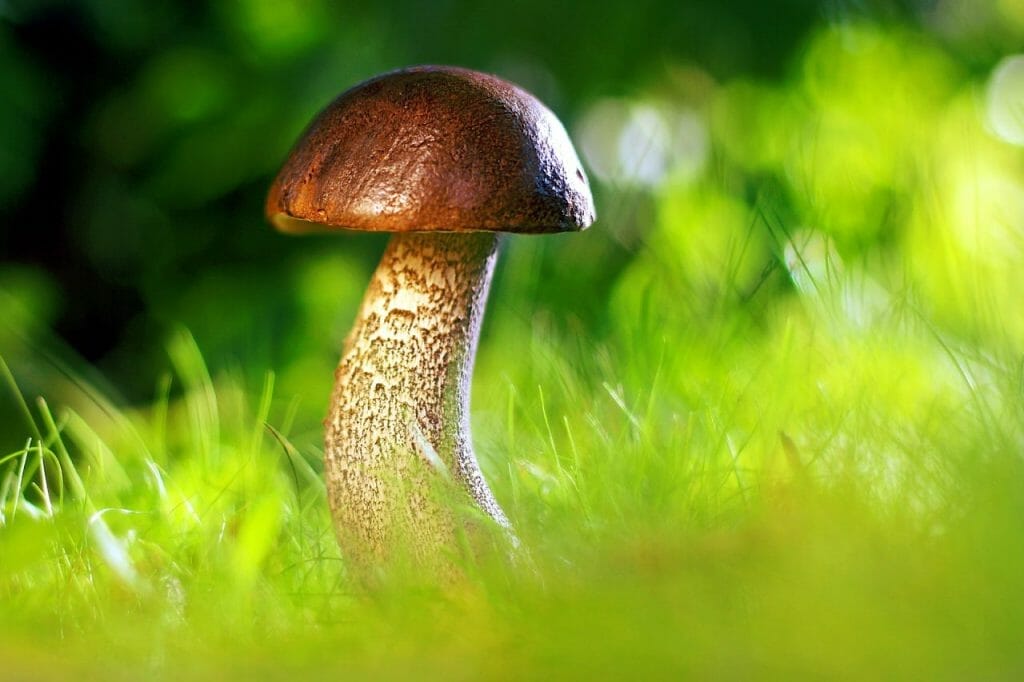
How to safely dose with the most potent mushroom strains.
Navigating the world of magic mushrooms requires an understanding of dosing, especially when dealing with species of varying potency. Ensuring an enjoyable and safe psychedelic experience involves carefully considering factors like strain, personal tolerance, and desired effects.
Here are some guidelines on how to dose for potent species of magic mushrooms with varying potency levels.
- Know the Species: Familiarize yourself with the specific species of magic mushrooms you plan to consume. Research their typical potency levels, as different species can vary significantly.
- Start Low and Go Slow: Regardless of the species, starting with a low dose is always wise, especially if you are unfamiliar with the strain or your own sensitivity. Gradually increase the dosage in subsequent sessions as needed.
- Use a Scale: Invest in a precision scale to measure your mushroom dosage accurately. This ensures you have better control over the amount you consume and minimizes the risk of accidental overconsumption.
- Consider Your Body Weight: Your body weight can influence magic mushrooms’ effects. As a general guideline, some experts suggest a dose of 0.2 to 0.5 grams per kilogram of body weight. Adjustments may be necessary based on individual sensitivity.
- Factor in Tolerance: If you’ve recently consumed magic mushrooms, your tolerance may still be elevated. Allow for a tolerance break to ensure you experience your chosen dose’s full effects.
- Understand the Desired Experience: Your reasons for consuming magic mushrooms can influence your dose. Lower doses (microdosing) are often used for subtle mood enhancement and creativity, while higher doses are associated with more intense and introspective experiences.
- Seek Guidance: If you’re new to magic mushrooms or uncertain about dosing, consider seeking guidance from experienced individuals or professionals. They can offer valuable insights and help you make informed decisions.
- Create a Safe Setting: Ensure you’re comfortable and safe before consuming magic mushrooms. This helps minimize the potential for adverse reactions or anxiety during your journey.
- Have a Trip Sitter: If you’re taking a higher dose or are inexperienced, having a trusted friend act as a trip sitter can provide reassurance and assistance if needed.
- Be Patient: Magic mushrooms can take some time to produce effects, so resist re-dosing too quickly. Wait at least an hour or more before considering additional consumption.
- Stay Hydrated and Nourished: While on a magic mushroom journey, remember to stay hydrated and have light, easily digestible snacks to maintain energy levels.
What to expect from experiencing the most potent psychedelic mushrooms?
Experiencing the most potent hallucinogenic mushrooms can be a profound and transformative journey, but it’s important to approach the experience with caution and awareness. Here’s a list of the effects of experiencing the most potent strains of hallucinogenic mushrooms, along with explanations for each:
- Altered Perception of Reality: Hallucinogenic mushrooms can lead to a distortion of your perception of reality. You may perceive colours, shapes, and patterns in a way that is different from your sober state. This altered perception is often a hallmark of the psychedelic experience.
- Intense Visuals: Potent mushrooms can induce vivid and intricate visual hallucinations, ranging from simple geometric patterns to complex, dreamlike scenes. These visuals can be both beautiful and awe-inspiring.
- Elevated Mood: Many users report a profound sense of euphoria and happiness while influenced by hallucinogenic mushrooms. This elevated mood can lead to feelings of joy and interconnectedness.
- Enhanced Creativity: Some individuals experience heightened creativity and inspiration when consuming the most potent psychedelic mushroom. This can lead to artistic and imaginative insights and ideas.
- Time Distortion: The passage of time can feel altered or even cease to have meaning during a mushroom trip. Minutes may feel like hours or hours like minutes, contributing to a sense of timelessness.
- Deep Introspection: Potent magic mushrooms often lead to introspective journeys, where individuals reflect on their thoughts, emotions, and life experiences. This self-reflection can be therapeutic and provide valuable insights.
- Spiritual or Mystical Experiences: Some users report profound spiritual or mystical experiences during their mushroom trips. These experiences may include a sense of unity with the universe, encounters with divine entities, or a feeling of transcendence.
- Emotional Release: Mushrooms can bring suppressed emotions to the surface, allowing individuals to confront and process them. This emotional release can be cathartic and healing.
- Heightened Sensory Perception: Sensory perception can become highly acute, with users reporting a heightened sensitivity to sounds, textures, and sensations. This can be both enjoyable and overwhelming at times.
Final thoughts.
It’s essential to emphasize the significance of responsible and informed use. The power of these potent mushroom strains should be harnessed with caution and respect. Understanding dosing, setting, and the legal context is crucial for safe and enriching journeys.
In the captivating realm of psychedelic mushrooms, potency is a key factor that shapes the intensity and depth of the experience. We’ve embarked on a journey through the world of the strongest mushroom strains, each with its unique characteristics and effects. From the awe-inspiring Psilocybe azurescens to the introspective Psilocybe cubensis, these fungi offer a spectrum of experiences that beckon exploration.
The evolving landscape of psychedelics, with promising therapeutic potential, underscores the need for continued research and responsible exploration. Whether you’re a seasoned enthusiast or a curious newcomer, the world of potent mushroom strains and shrooms online offers a profound opportunity for self-discovery, healing, and a deeper connection to the mysteries of consciousness.
Potent mushroom strains FAQs.
-
How many magic mushroom species are there?
It is estimated that there are around 200 species of psilocybin-containing mushrooms within the Basidiomycota mushroom family. Of these, most fall into the Psilocybe genus. It is worth noting that while these are the only known species, there are likely many more magic mushroom species we are not yet aware of, as they have been historically woefully understudied—until now.
-
Are all strains of magic mushrooms equally potent?
No, not all strains of magic mushrooms are equally potent. Potency can vary significantly between strains due to differences in their psilocybin and psilocin content, genetics, and growing conditions. Some strains are notably more potent than others.
-
What makes Psilocybe azurescens unique among magic mushroom strains?
Psilocybe azurescens stands out due to its reputation as the world’s strongest magic mushroom. Its potency, along with its preference for specific geographical conditions, makes it unique. It’s known for producing intense and transformative psychedelic experiences.
-
Can I cultivate highly potent mushroom strains at home?
Yes, it is possible to cultivate highly potent mushroom strains at home. However, it requires proper knowledge of mushroom cultivation techniques, including selecting the right strain, creating optimal growing conditions, and ensuring sterile procedures.
-
How can I accurately dose highly potent mushroom strains?
Accurate dosing is necessary for a safe and predictable experience. Use a precision scale to measure your dose, start with a low amount and gradually increase it in subsequent sessions based on your tolerance and desired effects.
-
How do psilocybin mushrooms work in the brain?
Psilocybin mushrooms work by activating serotonin receptors in the brain, especially in the prefrontal cortex, which is involved in mood, cognition, and perception. Psilocybin also affects other brain regions, such as the amygdala, which is involved in emotional processing, and the hippocampus, which is involved in memory formation. Psilocybin can alter the way people perceive themselves and their environment, as well as their sense of time and space.
-
What are the effects of the most potent magic mushroom strains?
The effects of potent psilocybin mushrooms vary depending on the dose, the individual, the setting, and the expectations of the user. Some common effects include intense visuals, introspection, spiritual insight, and mystical experiences. But if you're not careful with your dosing, some possible negative effects include anxiety, paranoia, confusion, nausea, and panic.
-
Can highly potent mushroom strains be used for therapeutic purposes?
There is growing interest in using highly potent mushroom strains for therapeutic purposes, particularly for conditions like depression, anxiety, and PTSD. However, research in this area is ongoing and should only be done under the professional guidance of an experienced guide or psilocybin therapist.
-
What is psilocybin therapy?
Psilocybin therapy is a type of psychiatric practice that involves ingesting a psychedelic substance that is native to a specific type of mushroom in a psychotherapeutic setting. Psilocybin therapy involves a patient taking psilocybin while in the care of a therapist.
The patient goes on a psychedelic journey in this controlled, safe environment, and the therapist facilitates their experience. The session lasts six to eight hours, which is the full duration of the medicine's effects. The goal of psilocybin therapy is to impact emotional obstacles and long-term problems expediently by utilizing the psychedelic journey, rather than spending months or years in talk therapy slowly working through them. Find and connect with a psilocybin therapist in Canada today through our Trusted Psychedelic Therapists portal.


